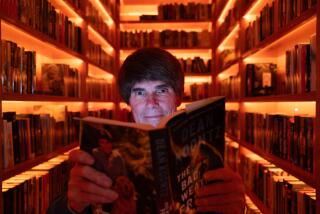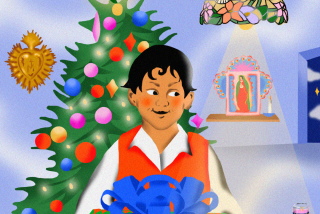Ho, Ho, Helllllp! It’s Santa’s Evil Twin, Bob
- Share via
Leave it to Dean Koontz to come up with the anti-Claus.
The Newport Beach author, whose dark suspense thrillers routinely propel him to the top of national bestseller lists, has written a story-length children’s Christmas poem. Santa’s coming to town, but don’t expect jolly old St. Nick.
Say hello to Santa’s evil twin, Bob.
In “Santa’s Twin” (HarperPrism), Koontz and illustrator Phil Parks give new meaning to the phrase “naughty and nice.”
Santa, you see, has been “mugged, tied up and gagged . . . locked in his cellar under the Pole, down in a dismal, deep, dark, dank hole.”
So forget about leaving out a cookie and glass of milk for Santa’s twin.
This Claus--”Oh, what a creep, what a scum and a louse”--opens the fridge and eats all the cake, then pours milk on the floor, not to mention “pickles, pudding, and ketchup--and more! He scatters the bread--white and rye--and finally he spits right into the pie.”
The nasty old elf, all “wicked and mean,” then swaps the presents under the tree for some really good stuff. You know, “dead fish, cat poop and fluff.”
Koontz fans first encountered Santa’s evil twin in “Mr. Murder,” his 1993 novel about a Mission Viejo writer whose happy family life is interrupted when his identical twin shows up saying, “You’ve stolen my life, my wife and my family, and I want them back.”
The problem is, the writer doesn’t have a twin.
Throughout the book, to help relieve the tension of all the terrible things his family is going through, the father recites a Christmas poem, “Santa’s Twin,” to his two young daughters at bedtime.
Koontz says he received more than 4,000 letters from readers complaining that he didn’t finish the poem.
“It never occurred to me that I had to finish it,” says Koontz, 51. “Then I thought, ‘Maybe there’s a book in this.’ It got me curious about what happened next.”
Koontz expanded the original 160 lines of verse that appear in “Mr. Murder” to about 580 lines. “I wasn’t expecting it to get that big,” he concedes. “But it turned into a full-blown adventure.”
Koontz teamed with Parks, who did the illustrations for Koontz’s previous foray into children’s literature, “Oddkins,” a 1988 book about the death of a magical toy maker whose toys come to life and battle the forces of evil. Parks also did the illustrations for a collector’s edition of Koontz’s 1985 suspense novel “Twilight Eyes.”
It took the artist, who lives in Royal Oak, Mich., 14 months to paint the 32 illustrations in “Santa’s Twin.”
In the beginning, Koontz wasn’t sure there would be a market for a book about Santa’s “fearfully freaky” twin brother. As he says, “It’s an odd book, so you never know.”
Not wanting Parks to waste more than a year of his time on a project that might not sell, Koontz told the artist that he would buy all the paintings he was doing for the book, and they agreed that if it did sell, they would split the proceeds.
HarperPrism, the first publisher approached by Koontz’s agent, immediately snatched up “Santa’s Twin.” And, Koontz says, “now I own 32 absolutely beautiful pieces of art.”
(Observant readers will notice that the face in the framed picture hanging on the wall of the little girls’ bedroom looks familiar: It’s Koontz.)
For his part, Koontz completed “Santa’s Twin” in just a few days.
“I tend to have fun with humorous verse,” he says, “so it’s more like play than work.”
All of which begs the question: Why Bob Claus?
Koontz says he was playing around with what to call Santa’s twin, and “Bob Claus struck me as the funniest name I could come up with. And you learn Mrs. Claus’ name for the first time: Bernice.”
*
Koontz enjoys poetry, and he periodically includes poems in his novels as epigraphs to point the reader to some of the book’s themes. The poems are always taken from “The Book of Counted Sorrows.” At least that’s what readers think.
“It’s a nonexistent book,” says Koontz, who writes the poems himself.
“We get about 3,000 letters a year from people wanting to know where they can get this book,” he says. Those include letters from frustrated librarians who have been searching for it. “I’ve made lots of enemies among librarians,” Koontz says.
To fans who write to him asking where they can find “The Book of Counted Sorrows,” Koontz responds by saying: “Remember when you were a kid and wrote reports and you made up footnotes because you didn’t want to do the research?” He goes on to explain that he was looking for a piece of verse one day to use in one of his novels and couldn’t find what he needed. Instead, he wrote something he felt was appropriate and attributed the poem to this make-believe book.
Koontz says “Santa’s Twin” is meant for both children and adults.
HarperPrism came up with the line on the back of the book jacket: “Read it aloud, preferably to someone whose laugh you love to hear.”
Says Koontz: “I think that’s exactly the whole spirit of the book, so parents and kids can have fun reading this together and talking about it.”
HarperPrism has printed 130,000 copies of “Santa’s Twin.” Because of the high cost of printing a book in full color in the United States, Koontz says, the book was printed in Hong Kong, bound in England and shipped to America.
Printing it out of the country, Koontz says, “is dramatically cheaper, but the drawback is to get a new printing shipped takes eight weeks. So if it sells well, they won’t be able to resupply for this Christmas.”
*
“Santa’s Twin” began hitting bookstores a few weeks ago. Koontz says he has heard from parents that their kids love the passages about Santa’s twin replacing the presents under the tree with some unusual surprises--such as Bob Claus taking out a watch and wrapping up in its place “a clot of horrid, glistening greenish toad snot.”
Koontz says some people have complained that the cover, depicting Santa’s devilish-looking brother clutching a frightened bunny in a black-gloved hand, is too scary for children.
But, as he reminds them, “this is Santa’s brother. This is not Hannibal Lecter. He’s just naughty, and he learns his lesson in the end.”
Indeed, in the end, Koontz says, “the two Santa brothers are reunited. And there’s a lesson here, that even the Clauses can be dysfunctional at times.”
More to Read
Sign up for our Book Club newsletter
Get the latest news, events and more from the Los Angeles Times Book Club, and help us get L.A. reading and talking.
You may occasionally receive promotional content from the Los Angeles Times.







